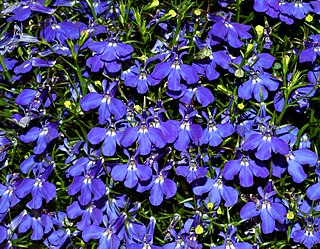
Lobelia is a genus of flowering plants comprising 415 species, with a subcosmopolitan distribution primarily in tropical to warm temperate regions of the world, a few species extending into cooler temperate regions. They are known generally as lobelias.

The family Campanulaceae, of the order Asterales, contains nearly 2400 species in 84 genera of herbaceous plants, shrubs, and rarely small trees, often with milky sap. Among them are several familiar garden plants belonging to the genera Campanula (bellflower), Lobelia, and Platycodon (balloonflower). Campanula rapunculus and Codonopsis lanceolata are eaten as vegetables. Lobelia inflata, L. siphilitica and L. tupa and others have been used as medicinal plants. Campanula rapunculoides may be a troublesome weed, particularly in gardens, while Legousia spp. may occur in arable fields.

Argyroxiphium sandwicense subsp. macrocephalum, the east Maui silversword or Haleakala silversword, is a rare plant, part of the family Asteraceae. The silversword in general is referred to as ʻāhinahina in Hawaiian.
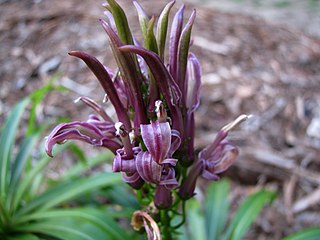
The Hawaiian lobelioids are a group of flowering plants in the bellflower family, Campanulaceae, subfamily Lobelioideae, all of which are endemic to the Hawaiian Islands. This is the largest plant radiation in the Hawaiian Islands, and indeed the largest on any island archipelago, with over 125 species. The six genera involved can be broadly separated based on growth habit: Clermontia are typically branched shrubs or small trees, up to 7 metres (23 ft) tall, with fleshy fruits; Cyanea and Delissea are typically unbranched or branching only at the base, with a cluster of relatively broad leaves at the apex and fleshy fruits; Lobelia and Trematolobelia have long thin leaves down a single, non-woody stem and capsular fruits with wind-dispersed seeds; and the peculiar Brighamia have a short, thick stem with a dense cluster of broad leaves, elongate white flowers, and capsular fruits. The relationships among the genera and sections remains unsettled as of April 2022.
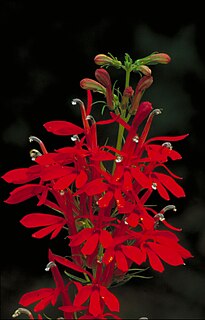
Lobelia cardinalis, the cardinal flower, is a species of flowering plant in the bellflower family Campanulaceae native to the Americas, from southeastern Canada south through the eastern and southwestern United States, Mexico and Central America to northern Colombia.
Plant reproduction is the production of new offspring in plants, which can be accomplished by sexual or asexual reproduction. Sexual reproduction produces offspring by the fusion of gametes, resulting in offspring genetically different from either parent. Asexual reproduction produces new individuals without the fusion of gametes, resulting in clonal plants that are genetically identical to the parent plant and each other, unless mutations occur.
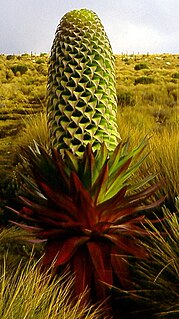
Lobelia deckenii is a species of flowering plant in the family Campanulaceae. It is a giant lobelia endemic to the mountains of Tanzania. It is listed as a threatened plant of the forests of Cherangani hills, Kenya. It grows in moist areas, such as valley bottoms and moorland, in contrast to Lobelia telekii which grows in a similar but drier habitat. These two species produce occasional hybrids. Lobelia deckenii plants usually produce multiple rosettes. Each rosette grows for several decades, produces a single large inflorescence and hundreds of thousands of seeds, then dies. Because individual plants have multiple rosettes, they survive to reproduce repeatedly, and plants with more rosettes flower more frequently. It is iteroparous.

Lobelia telekii is a species of flowering plant in the family Campanulaceae, that is found only in the alpine zones of Mount Kenya, Mount Elgon, and the Aberdare Mountains of East Africa. It occurs at higher altitudes on well-drained sloped hillsides. It is a semelparous species, putting all its reproductive effort into producing single large inflorescence up to 3 metres (10 ft) tall, and then dying. Inflorescences of L. telekii also possesses a large pith-volume for internal water storage and marcescent foliage which could provide insulation. It secretes a polysaccharide into this reservoir, which may be useful for its survival in the cold climate. The plant is named after the Austro-Hungarian explorer, Count Sámuel Teleki.

Lobelia dortmanna, Dortmann's cardinalflower or water lobelia, is a species of flowering plant in the bellflower family Campanulaceae. This stoloniferous herbaceous perennial aquatic plant with basal leaf-rosettes and flower stalks grows to 0.7–2 m (2.3–6.6 ft) tall. The flowers are 1–2 cm long, with a five-lobed white to pale pink or pale blue corolla, produced in groups of one to ten on an erect raceme held above the water surface. The fruit is a capsule 5–10 mm long and 3–5 mm wide, containing numerous small seeds.
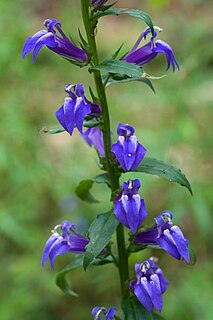
Lobelia siphilitica, the great blue lobelia, great lobelia, or blue cardinal flower, is a plant species within the family Campanulaceae. It is an herbaceous perennial dicot native to eastern and central Canada and United States. There are two recognized varieties of Lobelia siphilitica, Var. siphilitica and Var. ludoviciana. Blooming from August to October, it is short-lived, lasting only for a few years.

Lobelia kalmii is a species of flowering plant with a distribution primarily across Canada and the northern United States in temperate and boreal regions. It was formerly known as Lobelia strictiflora (Rydb.) It is commonly known as Kalm's lobelia, Ontario lobelia and Brook lobelia.

The flora and fauna of Mount Kenya are diverse, due to the variation in altitude, rainfall, aspect and temperature. The mountain slopes can be divided into vegetation zones, with each zone having different dominant plant species. Although many plants on Mount Kenya have local names, here they are reported only with their English and scientific names.

Lobelia urens, commonly known as heath lobelia or acrid lobelia is a species of flowering plant in the bellflower family. It is predominantly native to western Europe but can also be found in northern Morocco and in the island of Madeira off Northwest Africa.

Isopogon trilobus, commonly known as barrel coneflower, is a species of flowering plant in the family Proteaceae and is endemic to South Coast Western Australia. It is a shrub with wedge-shaped leaves with lobed or toothed leaves, and oval, spherical or barrel-shaped heads of cream-coloured to yellow flowers.

Lobelia niihauensis, commonly known as the Niihau lobelia, is a rare species of flowering plant in the bellflower family that is endemic to Hawaii. It is known only from the islands of Oʻahu and Kauaʻi and is thought to be extirpated from Niʻihau. It is federally listed as an endangered species of the United States.

Lobelia oahuensis is a rare species of flowering plant in the bellflower family known by the common name Oahu lobelia. It is endemic to Hawaii, where it is known only from the island of Oahu. There are about 100 individuals remaining in the Koʻolau Range, and only one known individual in the Waianae Range. It is federally listed as an endangered species of the United States.

Persoonia myrtilloides, commonly known as myrtle geebung, is a plant in the family Proteaceae and is endemic to New South Wales. It is an erect to spreading shrub with elliptic to egg-shaped leaves and yellow flowers in groups of up to forty on a rachis up to 170 mm (6.7 in) long.

Lobelia laxiflora is a species of flowering plant in the family Campanulaceae. It is native to the Americas, where it is distributed in South, Central, and North America as far north as Arizona in the United States. It is known by several English-language common names, including Mexican lobelia, Sierra Madre lobelia, Mexican cardinalflower, looseflowers lobelia, and drooping lobelia. In Spanish and Nahuatl it is known as aretitos, acaxóchitl, and chilpanxóchitl. It has gained the Royal Horticultural Society's Award of Garden Merit as an ornamental.
Lobelia brevifolia, the shortleaf lobelia, is a flowering plant species in the genus Lobelia. It is a perennial dicot in the Campanulaceae (bellflower) family. It grows in the Southeastern United States, in parts of Florida, Alabama, Mississippi, and Louisiana.
Polygala boykinii, known by the common name Boykin's milkwort, is a species of flowering plant. It grows to about 2 feet high and produces a spear of white flowers. It is a dicot in the Polygalaceae family. It has been collected in Florida and Alabama.















